Bulletin #1038, Winter Blanketing Guide for Equines in Maine
Bulletin #1038, Winter Blanketing Guide for Equines in Maine (PDF for printing)
By Rachel White, PhD, Extension Educator, University of Maine Cooperative Extension
Reviewed by Dr. Kelsey Hilton, Veterinarian, Annabessacook Veterinary Clinic
For information about UMaine Extension programs and resources, visit extension.umaine.edu.
Find more of our publications and books at extension.umaine.edu/publications/.
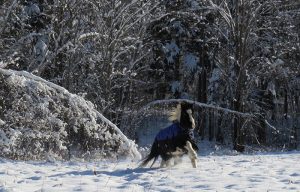
When blanketing horses in the winter months in Maine, there is no one-size-fits-all approach. For instance, one horse’s coat may be clipped to reduce sweat for exercise, while another horse is left in full fuzz. In this case, the clipped horse will need an extra layer more often than the unclipped horse. When a horse’s coat is left long, it creates a natural insulative layer. However, even horses with the thickest natural coats may need an extra layer.
These guidelines are offered as the basis for constructive discussion and reasonable solutions. It is important to understand each horse’s blanketing needs and to learn their individual blanketing preference indicators. Spending time with your animals in varying weather conditions will help you learn about their needs and preferences based on behavior and physical indicators (i.e., shivering, not leaving a shelter, etc.).
Factors to consider when deciding to blanket a horse
Decisions to blanket and with what type of blanket are situation-dependent. Coat type, body condition and age; weather, including temperature and windchill, and housing arrangement are factors to consider when choosing which blanket to use and when.
Coat
A horse’s coat length and thickness determine the need for blanketing at different temperatures. A fully or partially clipped horse will need several blankets for temperatures ranging from 40 ͦ F and below and for indoor and outdoor use. Horses that are adapted to cold winters and that are left in their natural coats generally require minimum blanketing provided that they are in good body condition and have access to adequate caloric intake and fresh water at all times. Thick, long coats effectively trap in air and help warm the animal. When that coat is wet or compressed from a blanket, air warming becomes less effective. Horses coming from warmer climates shortly before or during winter likely will not have grown a winter coat and should be blanketed similarly to that of a clipped horse. Remember that it may take 1–2 winters before a southern horse fully adapts to a winter climate.
Body Condition & Age
Because of the excess energy demands needed to thermoregulate in cold weather, horses with a body condition score of 4 and below may struggle to keep warm. Hard keepers and elderly horses are especially vulnerable, as their fat stores might not be adequate to keep up with energy demand. Elderly horses also may not grow their coats as thick as when they were in their prime. Foals born in winter months may need extra insulation when turned out.
See University of Maine Cooperative Extension Bulletin #1010, Equine Facts: Body Condition Scoring for Your Horse.
Weather
Snow on its own typically requires no extra layering for a healthy and fluffy horse. It may melt a bit, but the natural coat will trap air within itself, causing a warm (against the skin) -to-cold (against snow) insulative layer and the snow will remain intact on the horse’s neck and back. Heavy sleet or freezing rain, and cold spring/ fall rains, however, may soak through the fuzzy coat, causing the horse to shiver. NEVER blanket a wet horse- whether the coat is wet from riding or from rain, towel dry or use a blow dryer before adding a non-breathable blanket.
Forecasted air temperatures should be checked daily for decision-making. Ambient air temperatures in single digits or negative degrees (- ͦ F) generally require blanketing for fuzzy horses. Additionally, when windchill turns the air into these low temperatures, a pastured horse can become chilled because their coated insulative layer releases warm trapped air.
If the temperature goes up during the day, removing the blanket in the morning can help the animal thermoregulate better than if left on all day. Their coat will fluff up again, creating that air layer. If the same blanket that was put on the night before at 10 ͦ F is kept on at 40 ͦ F, that animal may sweat, which may lead to shivering come nightfall when the temperature drops again.
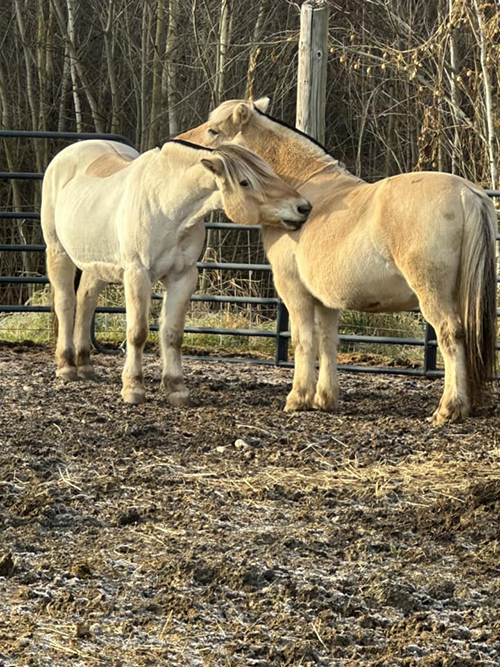
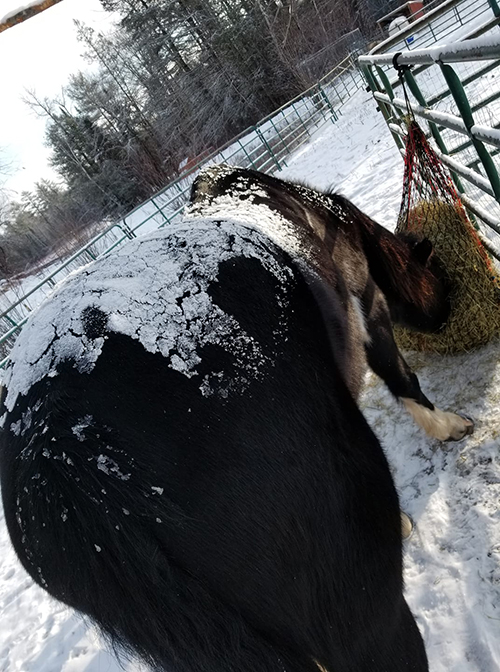
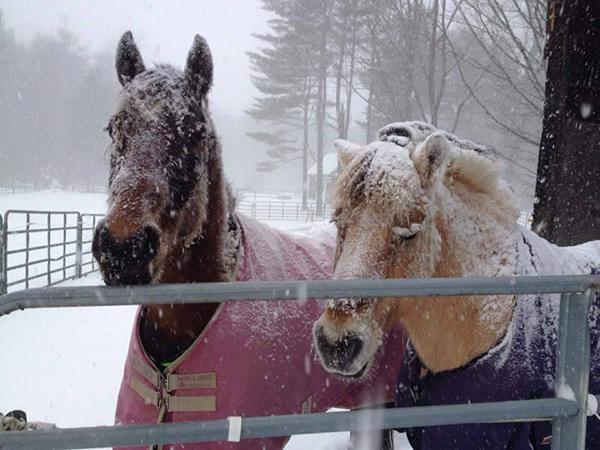
Shelter
Protection from the elements can come in many forms- a three-sided run, a group of fir trees, a shed row, stalls in a barn, etc. In Maine, a three-sided shelter is required for equines. Even with a roofed structure, there are some horses that will not use a barn or will choose to stand in the elements. Placing hay in the run or under cover may provide extra protection from precipitation and wind. Shaggy horses kept in stalls in a barn at night may not require additional layers, but some barns that stay at- or below- outdoor ambient air temperatures (e.g., high ceilings) may result in the need for horses to wear a stable sheet. Having a thermometer in the barn will help determine whether to blanket or not.
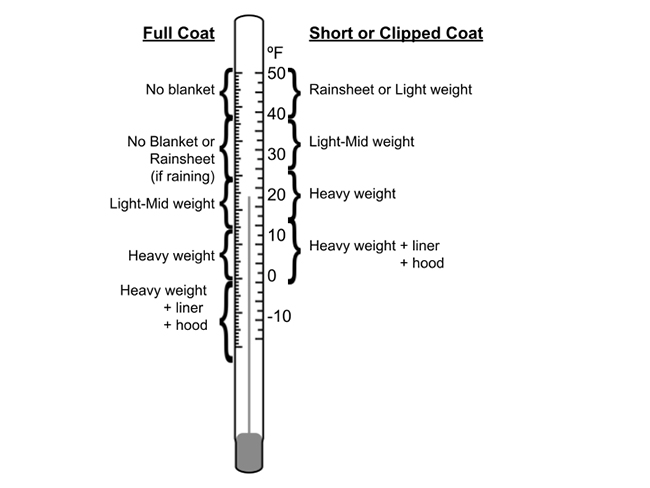
Types of Blankets
There are many blankets marketed for different uses. The table below includes common examples:
| Type | Grams (g) |
|---|---|
| Stable sheet or liner | 0 |
| Quilted liner | 100-300 |
| Rain sheet | 0 |
| Light weight | 60-100 |
| Medium weight | 150- 300 |
| Heavy weight | 300+ |
Waterproofing
Always check to make sure blankets are labeled as waterproof before use in precipitation events. In general, liners and stable sheets are not designed to get wet. Remove saturated blankets and dry them. In periods of extended wet weather, switching from a rain sheet to lightweight sheet will give time for blanket drying periods and maintaining a dry horse.
Deniers (D) indicate the strength and thickness of the material weave, which relates to the durability of the blanket. A 1200D blanket will be stronger and likely will last longer than a 600D blanket.
Grams refer to the polyfill insulation within the woven fabric of the blanket. The higher the gram count, the heavier the insulation.
Hoods are attachable pieces of blankets that cover the neck of the animal.
How to Fit a Blanket
Ensuring a proper fit of blankets is important to prevent skin sores and entanglement. If blanketed for long periods, occasional blanket removal is encouraged to check for rub spots and body condition. Additionally, much like pant size, each blanket brand may have a different way of fitting.
Measuring fit
To measure a horse for a blanket in inches, measure from the center of the chest, across the point of the shoulder, to the center of the dock (tail). A fabric tape or string works well for this. When trying on a new blanket, check for potential rub spots by sliding a hand under the blanket and against the point of the shoulder and withers. If it is hard to fit a hand in these areas, loosen the chest straps or try a larger size.
How to put on/ take off a blanket
Below are recommended steps for how to put on a blanket. Horses should be trained prior to blanketing not to be fearful and to stand safely. Always ensure control of the animal by tying or holding the lead.
- Identify the front of the blanket from the back and slowly put it onto the horse.
- Fasten the chest buckles or clips. Clip openings should rest toward the animal and not face outwards, as to not get caught on hay bags or other hazards. Loosen/ tighten as needed after completing the last step.
- Criss-cross belly straps and buckle to the opposite side. These should cross at the center of the stomach. Loosen/ tighten as needed, allowing for three fingers to comfortably fit between the center of the belly and the strap and not too loose to fit a rear hoof.
- Attach the rear leg straps either by crossing the front right strap through the left and clipping to the back right side (and left attaching to the left side) or by making an “x” by the front right strap clipping to the left back side (and front left to back right). Loosen/ tighten to allow for some drooping, but not too low so as not to get a hoof caught.
- Some blankets only have one strap at the rump which goes under the tail.
To take off the blanket, reverse order these steps by starting from the rump working up to the chest straps. Removal of blankets in the winter sometimes causes static cling and can shock the horse. Rubbing the blanket with dryer sheets can prevent this.
Special Considerations for other Equine Species
Donkeys, mules, and other domestic equines other than horses may need additional considerations when deciding to blanket. Donkeys are more sensitive to temperature changes and precipitation than their horse counterparts. Their coats are typically thinner and less waterproof, so they may need blankets or shelter sooner than a horse would.
For other equine winter care tips, see University of Maine Cooperative Extension Bulletin #1007, Equine Facts: Winter Care for Horses
Temperature scale interpretation
For full coated horses: 40 ͦ F and above, no blanket; 25 ͦ F- 39 ͦ F, no blanket or rain sheet if raining; 15 ͦ F-24 ͦ F; light or midweight blanket; 0 ͦ F-14 ͦ F, heavyweight blanket; below 0 ͦ F heavy weight blanket, liner, and hood. For clipped horses: 40 ͦ F-50 ͦ F, rain sheet or lightweight blanket; 25 ͦ F- 39 ͦ F, light or midweight blanket; 15 ͦ F-24 ͦ F, heavyweight blanket; below 15 ͦ F heavyweight, liner, and hood.
Information in this publication is provided purely for educational purposes. No responsibility is assumed for any problems associated with the use of products or services mentioned. No endorsement of products or companies is intended, nor is criticism of unnamed products or companies implied.
© 2025
Call 800.287.0274 (in Maine), or 207.581.3188, for information on publications and program offerings from University of Maine Cooperative Extension, or visit extension.umaine.edu.
In complying with the letter and spirit of applicable laws and pursuing its own goals of diversity, the University of Maine System does not discriminate on the grounds of race, color, religion, sex, sexual orientation, transgender status, gender, gender identity or expression, ethnicity, national origin, citizenship status, familial status, ancestry, age, disability physical or mental, genetic information, or veterans or military status in employment, education, and all other programs and activities. The University provides reasonable accommodations to qualified individuals with disabilities upon request. The following person has been designated to handle inquiries regarding non-discrimination policies: Director of Equal Opportunity and Title IX Services, 5713 Chadbourne Hall, Room 412, University of Maine, Orono, ME 04469-5713, 207.581.1226, TTY 711 (Maine Relay System).

